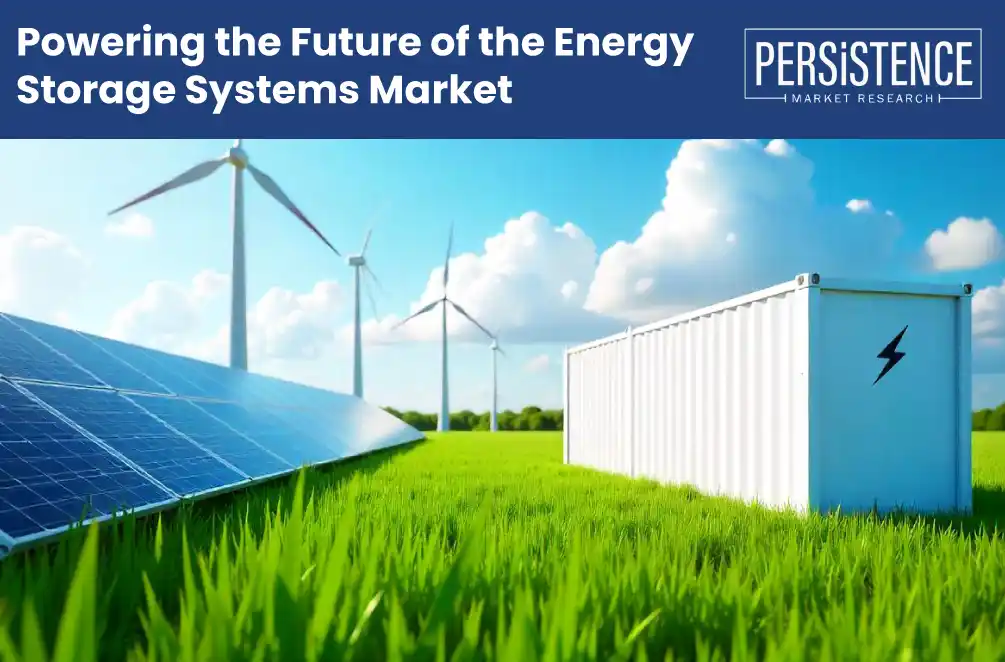- Blog
- Energy Storage Systems Trends
Powering the Future of the Energy Storage Systems Market
Published On : 1 Jul 2025
The global energy sector is rapidly transforming, with clean energy at the forefront. Central to this transformation are energy storage systems (ESS) technologies that enable the storing and later use of electricity. Whether stabilizing the grid, supporting the growing number of electric vehicles, or making renewable power more reliable, ESS technologies have become essential in the clean energy ecosystem.

What are energy storage systems and why do they matter?
An energy storage system is a way to capture energy when it’s abundant and use it when it’s needed. ESS can store energy in many forms, chemical (like batteries), mechanical (like pumped hydro), or thermal (storing heat) and then convert it back to electricity on demand. This function is vital because renewable energy sources such as wind and solar don’t produce electricity consistently; they depend on weather and time of day.
By bridging this gap, energy storage smooths out supply fluctuations, making the power system more reliable and flexible. It also helps avoid costly and polluting backup power from fossil fuels, supporting the transition to a cleaner energy grid.
What drives the boom in energy storage?
First, the massive deployment of renewable energy, particularly solar and wind, has created a need for systems that can store excess energy and release it when production dips. Without storage, grid operators face challenges balancing supply and demand. Second, the shift toward decentralized energy systems microgrids, distributed generation, and smart grids demands more localized storage to manage energy flows effectively. Third, the rise of electric vehicles fuels demand for batteries, both for vehicles and for stationary storage applications. Additionally, concepts like vehicle-to-grid (V2G) allow EVs to act as mobile energy storage units, adding flexibility to the system.
Government incentives and policies are also fueling adoption worldwide. The U.S. Inflation Reduction Act, for example, provides tax credits for standalone storage projects, encouraging further investment. Finally, declining costs, particularly for lithium-ion batteries, make storage more affordable and scalable than ever before, driving broad adoption.
What technologies are leading the energy storage revolution?
Lithium-ion batteries lead the market thanks to their high energy density, reliability, and versatility across residential, commercial, and utility-scale projects. Pumped hydro storage remains the largest form of installed storage worldwide, using water reservoirs to store energy, although its expansion is limited by geography. Flow batteries are emerging as a strong option for long-duration storage, particularly useful for utility-scale renewable integration because they can deliver energy over longer periods without degradation.
Thermal storage, which stores heat energy for later use, finds applications in concentrated solar power plants and industrial processes. Hydrogen storage is an emerging technology with great promise. It converts electricity into hydrogen via electrolysis, which can be stored for long periods and used later in fuel cells or as clean fuel.
Which regions are leading in energy storage?
North America, especially the United States, is at the forefront of energy storage deployment. States like California, Texas, and New York have robust renewable energy policies and are aggressively integrating ESS to support grid reliability and sustainability goals.
Europe is also moving rapidly, with Germany, the UK, and Italy investing heavily in both residential and utility-scale storage. The European Green Deal and ambitious decarbonization targets are key drivers. In the Asia-Pacific region, China leads the charge with large-scale projects supporting its massive renewable rollout. Other countries like Japan, South Korea, and Australia are also significant players, spurred by government incentives and growing clean energy demand.
What challenges does the market still face?
Regulatory uncertainty in some regions can slow adoption, as energy storage often falls into unclear policy categories. Supply chain constraints, especially for critical materials such as lithium, cobalt, and nickel, present risks to production and pricing. Battery recycling and environmental impacts at end-of-life remain concerns that the industry must address to maintain sustainability.
Lastly, while costs have fallen, the upfront capital required for large storage projects remains a barrier for many, particularly in developing markets. Addressing these issues will require continued innovation, regulatory clarity, and investment in sustainable supply chains and recycling infrastructure.
What is the future of energy storage?
Looking ahead, energy storage will become increasingly central to global energy systems. Long-duration storage technologies are gaining traction, enabling storage over days or weeks, which is crucial for seasonal renewable energy balancing. Repurposing second-life batteries from electric vehicles for stationary storage extends their value and reduces waste.
The market will also see growth in new business models like energy-as-a-service, where customers pay for energy flexibility without owning the hardware. Advanced software and AI will optimize storage usage, improving efficiency and reducing costs.
Overall, energy storage is poised to become the backbone of a clean, resilient, and flexible energy future.
Industry Report

Request Report Sample
Your privacy is important to us; your data is secure
Contact Us
Latest Reports
-
Piezoresistive Pressure Sensor Market by Sensor Type (Absolute, Gauge, Differential, Sealed), Pressure Range (Low Pressure (<10 kPa), Medium Pressure (10 kPa – 1000 kPa), High Pressure (>1000 kPa)), End-Use Industry (Automotive & Transportation, Industrial Manufacturing, Healthcare, Aerospace & Defense, Electronics) and Regional Analysis for 2026-2033
-
Aquarium Accessories Market by Product Type (Filtration Items, Lights & Hoods, Temperature Control Systems, Others), End-User (Residential, Commercial), Distribution Channel (Online, Offline), and Regional Analysis for 2026-2033
-
Oxygen Therapy Market by Product Type (Compressed Oxygen, Concentrated Oxygen, Liquid Oxygen), Disease (Respiratory Disorder, Cardiovascular Disease, Sleep Apnea, Pneumonia), End-User (Hospitals, Home Healthcare, Clinics), and Regional Analysis for 2026-2033
-
Air Curtains Market by Product Type (Non‑Recirculating, Recirculating, Heated, Others), Airflow Capacity (Up to 500 m³/h, 500–1000 m³/h, 1000–1500 m³/h, Above 1500 m³/h), Application (Commercial, Industrial, Residential, Others), and Regional Analysis for 2026–2033
-
Personalized Stationery Market by Product type (Storage & Filling Products, Paper-Based Products, Drawing & Writing Instruments, Accessories, Bags, Others), Application (Educational Institutes, Corporate Offices, Personal Use, Hospitals, Others), and Regional Analysis for 2026–2033
